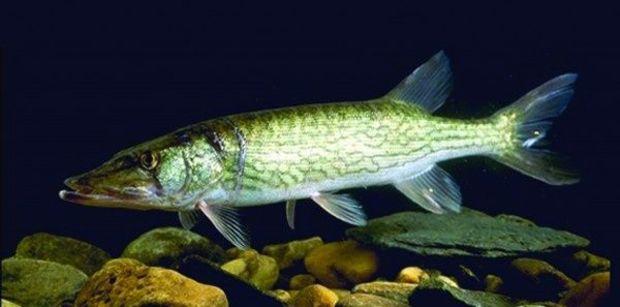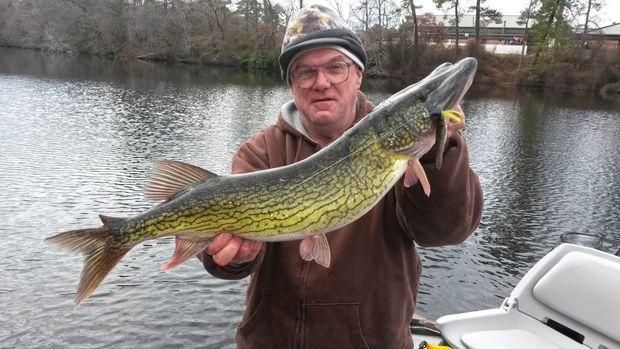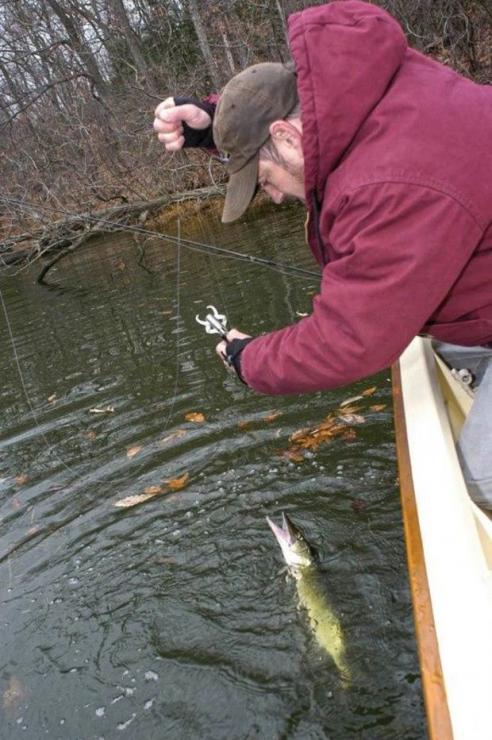My first true trophy chain pickerel inhaled a fly retrieved among the fallen timber ringing a magical tidal pond not far from Annapolis. It was a lucky catch; I say that because I’d been working that stretch of steep bank for an hour, and though I caught a few small ones, it seemed like every fifth cast I’d get hung up.

So I thought I was snagged again, since when I tried to retrieve the line it hardly moved. I guess the fish was slow to realize it wasn’t a minnow sipped into its gullet but rather a thin piece of sharp steel. Once the pike did process its mistake, it took off like a Wallops Island rocket, trying to break me off among the snags. When I pulled it into more open water, the fish executed a few aerial walks as if to express its indignation at being fooled.
The fly that the fish struck was of my own invention, as much as any fly really can. Based on the incomparable Clouser design, I called my paltry knockoff “Igor.” Tied onto the 1/0 hook shank was a clear monofilament underbody dressed with pale chartreuse bucktail and yellow chicken feathers. The pièce de résistance? Over-sized red plastic eyes glued to each side of the barbell weight attached near the hook eye. Believe me, it looked like Mel Brooks’s Igor (it was that ugly).
This was when the first Clinton was winding down his second term in the White House, on an unseasonably pleasant February afternoon that offered soul-soothing bursts of sunlight radiating down from 93 million miles away. The day began with banks of fog rolling by as if I were part of an Ansel Adams photograph. Conditions were in stark contrast to the previous week when skim ice blanketed the creek. Put more simply: your protypical pickerel fishing weather.
Since that catch, I, like untold numbers of Chesapeake Country fishermen, welcome a pickerel fishing sojourn any chance I get. It offers relative solitude and a much-needed respite from winter’s tenacious grip. To me, those who focus only on the obvious—that chain pickerel are a ferocious-looking fish, appearing almost prehistoric with a crude jaw full of sharp, ragged teeth not unlike a crocodile’s smile—are missing the point. First off, these fish are beautifully colored: a mystical green-bronze body marked with a chainmail patterned that runs from gill plate to caudal fin. Second, they can either make bone-jarring strikes or frustratingly subtle takes, and it’s up to you to figure out which is which on any given day. And third, in some ways their presence, or lack of it, indicates whether or not we’re taking good care of those smaller waters in which they live.

Chain pickerel are found in most of Chesapeake’s tidal waters that run to the fresher side. And while cold weather fishing is best—usually October through February as long as it doesn’t get too frigid, in my experience—you can catch them year-round. As ambush predators, pickerel want to be where forage seeks protection. As such, you’ll catch them around downed trees and stumps, grass beds, and other structures. Voracious, ambush predators, pickerel lurk in among these habitats, waiting to snatch up unsuspecting prey, including small fishes, such as mummichogs and killifish, as well as juvenile white and yellow perch. Frogs and baby birds might be so unlucky, too.
It has been observed that populations of these “green wolves” are most stable wherever Bay grass acreage has flowered. Underwater grasses, such as horned pondweed, common waterweed, redhead grass, and Eurasian milfoil, provide the perfect camouflage for the solitary pickerel to hunt prey. Relatives of the northern pike and muskellunge, our chain pickerel spawn when water temperatures approach 50 degrees Fahrenheit, and usually that’s around March. The female releases a mass of ribbon-like eggs, as many as 50,000, that hang on plants, sunken tree limbs or any similar structure. Once the female releases her brood, her job is over; she doesn’t hang around to protect them like some other fishes. Pickerel are fast growers. If the conditions are right, they may push seven or more pounds and stretch to 36 inches, though much more common in our waters are fish in the 14- to 20-inch range, a size they reach usually by their third season. The following year pickerel can reproduce.

Arguably minnows on a jighead is the best way to catch a pickerel. But the most fun, in my opinion, is casting lures on light spinning (six to 10 pounds) or flies on five- or six-weight outfit. Proven standards like Clousers or Deceivers, or similar patterns like a Half-and-Half tied on a standard shank hook (#1 to 2/0). I’ve seen pickerel strike a lure with startling ferocity. Other times, their take is as easy as a Sunday morning.
Once, on a slow day of pickerel fishing, one curious fellow followed my lure so close that I could almost touch it. Then, it gazed up at me with an odd calmness, and as if a ghost slipped back into the green water from where it can. I’ve heard one angler describe them as a weird and wonderful fish. Whatever your gear preference, pickerel fight hard, giving or asking no quarter. I’m of the strong opinion they should be released, not only because they rank relatively low as table fare but because populations have historically been subject to worrisome swings. It’s a gamefish much deserving of respect, a worthy quarry for any angler looking for sweet reaffirmation that weird and wild things still swim among us.
Slow Your Roll
Pickerel fishing can be an awesome winter time activity, but pick your days. At this time of year, it's not unheard of to start your day with sunny skies and a balmy 50-plus degrees only to see the mercury plummet by double digits within hours. Let caution be your guide, however, since even the most picturesque and quiet pond poses the the risk of hypothermia. Lifevests are a must. Dry suits are the best if you're paddling; splash pants or chest waders are better than jeans. Fish with a partner or more to reduce the risk.
by Capt. Chris D. Dollar